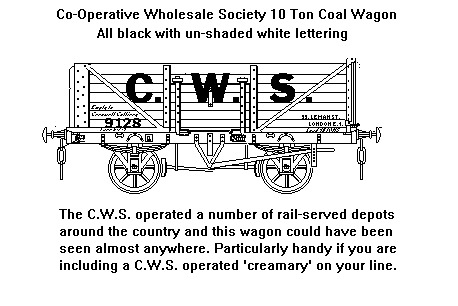
| Return to index page |
Liveries on Private Owner Rolling Stock
NB The colours used were obtained by sampling colour pictures, they may however vary from the true colour, use as a rough guide only
Private owner wagons were originally rather drab, even with the switch to standard RCH wagons in the 1880's most collieries simply painted their wagons black with the company initials on the sides in white. Following the lead set by the early railway companies a symbol such as a clover leaf or diamond shape which illiterate staff could recognise was often used to mark rolling stock. By the 1870's coal merchants wagons often featured quite elaborate colour schemes as part of their function was to act as mobile advertising for the companies concerned. Some private owners used a light brown varnish or preservative on the insides of open wagons and a few used a black bitumen compound, intended to make it easier to sweep out the wagon between loads.
The more colourful liveries are best left to the ready to run market but there are simple livery options available which can be applied to kits or to second hand stock in inappropriate liveries. My original layout was set in the Forest of Dean, an area served by both the GWR and LMS. I looked for suitable liveries but over twenty years ago there weren't any. The Ocean wagon then available from Farish was associated with a colliery in North Cornwall so I collected a few of those and added more as simple repaints of Lima bodies (on Peco chassis) and Peco wagon kits. A selection of easy to apply mineral wagon liveries has been included in the section on Livery Modifications (see Fig ___).
The liveries used on private owner stock were generally simplified during the hard times of the 1920's and 1930's, many coal wagons for example changed to a plain black body with un-shaded lettering. By the end of the `30's firms such as ICI had changed to using the company initials in place of the full title, similarly the Cooperative Wholesale Society coal wagons were painted plain black with un-shaded white lettering from the 1920's.
Fig ___ CWS Coal Wagon 
A typical local Co-Operative Society wagon livery by the later 1920's would be similar to the Lima 'OO' milk tank: a dark green body with white lettering; C W S about 18 inches or 2 feet high on the side. There was a three figure wagon number to the lower left about 6 inches high over the load (in this case 10 Tons) in lettering about 4 inches high and its home town in the lower right about 6 inches high. All script being sans serif and all but the load shaded black. Do note however that the base colour on Co-Op stock owned by a local society was not always green.
Prior to the introduction of its circular 'logo' ICI used white shaded black lettering, with only two full stops (I.C.I), generally about 18 inches (45 cm) high. ICI's salt stock (both wagons and vans) was painted cherry red with the ICI spaced centrally on the body and, in the case of the salt vans, the word SALT about a foot high to the lower right.
Care is required on this issue, especially when working from un-dated photographs or commercial 'OO' scale models. For the CWS and IMS milk tank wagons produced in OO by Lima are in liveries which appeared in about 1939 and 1940 respectively. Milk tank liveries are discussed in more detail in the section on milk traffic in the Freight Operations -Non passenger coaching stock - Milk section but broadly speaking they were quite elaborate prior to the late 1930's.
Each private owner wagon had to be `registered' with the railway company on who's lines it was normally `at home', this ensured the wagon was fit for use and enabled the charging for repairs. On the left hand end of the sole bar would be the cast metal 'registration plate'. There was usually a `return to' marking, generally painted to the lower right or left of the body side (return-to instructions relating to pre grouping companies were still marked on some ex private owner wagons operating in the 1950's).
For safety reasons all wagons and vans have to be marked with their maximum load and their tare weight. On mineral wagons with ends doors some private owners added the standard \ / marking on the lower body side but this was mainly done with colliery and colliery agents wagons.
Another marking often seen on private owner stock after the First World War and quite common from the 1920's on, is a small yellow five pointed star generally placed to the lower left of the wagon side. Where a light body colour was used the star was placed in a black patch.
These markings indicated that the wagon had been `pooled' by the owners under an arrangement with the RCH. Quite common on coal wagons or other bulk mineral wagons these markings would not usually be seen on more specialised stock such as salt vans. The oil companies had a similar arrangement for pooling wagons via the RCH and they used the same star markings, however only a proportion of their stock was pooled. There were some unusual cases of pooled (or apparently pooled) stock, for example the three compartment beer tank shown in Fig___. This wagon has the pool markings on the lower left of the tank but the sketch was made from a photograph of a freshly painted wagon and when in service these markings might well have been painted out.
In 1939 the private owner mineral wagons were requisitioned by the
government and pooled to meet wartime demand. This was not done with the more
specialised items, such as salt wagons, which were marked `non pool' or with
the letters NP, usually in white on a circular or heart shaped patch generally
about 4 inches (10 cm) high) to the right of the number. These NP mineral wagon
markings should only be seen on layouts set in the 1940's or later. In later
years the words Non Pool were sometimes used in place of the NP marking (for
example see the cement van and pressflo wagons below).
One
occasionally see another marking in the lower left of PO wagons and tanks, this
consists of the letters Cc (one inside the other) in a yellow patch. This
marking showed that the company operating the wagon had come to an arrangement
with the railways regarding charging called the 'Commuted Carriage Charge'.
Fig ___ 'Pool' and CC markings

During the war end-door private owner coal wagons had a diagonal white line added right across from the bottom of the non-door end to the top of the door end, this was painted over whatever livery they had. These wagons would still have borne these markings in the early 1950's, although all the remaining ex private owner wooden bodied mineral wagons with grease filled axle boxes were burned by British Railways at about this time. Some private owner wagons were built during both the first and second world wars, these usually had very simple small lettering styles confined to the upper body sides.
Fig ___ Wartime private owner wagon liveries
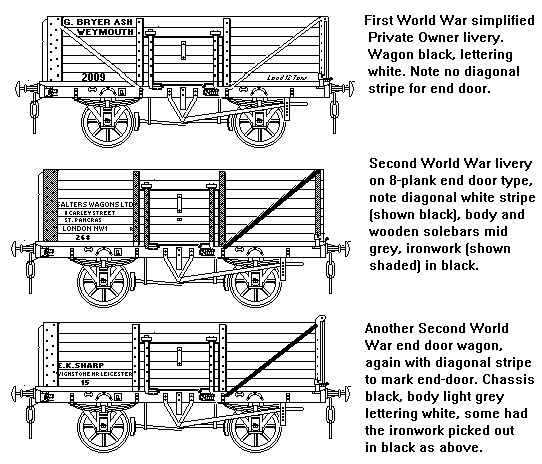
A few privately owned mineral wagons were not pooled however and steel works, coal mines and other large industrial sites with their own railway system retained their own 'internal use' loco's and rolling stock.
Internal use only rolling stock is often of an obviously non-standard design but standard wagon types are also used in some numbers. To avoid these getting loose on the general railway system they are usually painted in distinctive colours. For example the Stewarts & Lloyds steelworks had steam and diesel loco's painted yellow with black chevrons on the ends and their internal rolling stock was painted yellow on the upper body sides (the top two or three planks on a wooden 'mineral' type wagon). The coal mines used a large number of mineral type wagons and even had some brake vans and a few unusual wagons. The two-plank coke wagon in the drawing below operated on a private colliery railway in the Jarrow area. It has been sketched from a photograph in Peter Mathews' book on private owner wagons (for details of which see bibliography). The internal use brake van is again a colliery type, sketched from a photograph in one of Bill Hudson's books on private owner rolling stock (again see bibliography).
The National Coal Board settled on a standard livery of bauxite often with either a couple of planks painted white or with large white NCB lettering. Some NCB steel bodied mineral wagons were often light grey but had N C B on the lower left side in white, each letter being on a square black patch. The 16 ton and 21 ton mineral wagons made redundant by the closure of the coal hoists at the Welsh docks were sold to the NCB who painted them plain grey or sometimes bauxite lettered in white and without the diagonal stripe indicating the end door.
Fig ___ Internal User rolling stock
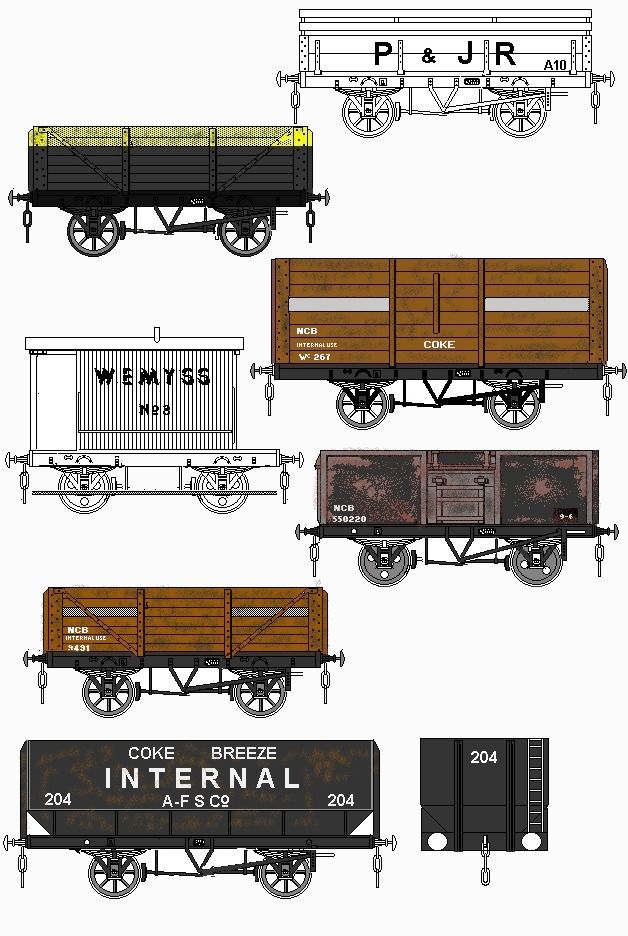
Most large industrial complexes boasted their own internal railway and most had a link to a near-by main line. The Cadbury works at Bourneville had its own rail network with a link to the railway system as early as 1884 (this link was closed in 1976).
Non common user vacuum braked ten foot wheelbase private owner stock, such as grain wagons, salt wagons, lime and stone wagons, remained in service into the mid 1970's and the vacuum braked ICI bogie limestone hopper wagons have survived at least into 1997.
In the immediate post war period there were few privately owned wagons other than tankers operating in Britain. Most tank wagons were private owner stock but there was little interest in other forms of private owner vehicles at the time. One exception was the ferry traffic, which included a number of leased continental vehicles as well as rolling stock belonging to foreign railway companies.
In the 1960's and early 1970's British Rail concentrated on block trains
and introduced designs such as the HAA MGR hoppers. On the private owner front
the re-vamp of the oil haulage business saw a flood of private owner tankers
entering service and cement firms started using private owner 'Presflo' wagons
in the late 1950's.
Cement is nasty stuff so the railways were allowed
to refuse it as cargo, as a result there have been PO cement vans since the
early twentieth century. The various firms consolidated around the turn of the
century, one group formed Associated Portland Cement Manufacturers formed in
1900, most of the remainder formed into British Portland Cement Manufacturers
formed in 1912, these merged their marketing under the Blue Circle CMC brand in
1920 and in the mid to late 1960's the CMC inside the blue ring changed to Blue
Circle. The early vans were often the GWR Iron Mink type and these often
featured complex and colourful liveries. The N Gauge Society offers a kit of
such a van along with transfers to suit. Not all vans were of this type
however, the sketch below shows an early van from the 1920's and a BR era van
from 1964.
Fig ___ PO Cement liveries.

The Blue Circle presflo wagons started life in all-over yellow but this showed up the white stains of the cement so a light gray body was adopted, with yellow side boards bearing the Blue Circle branding. The BR Presflow wagons were also pressed into service for alumina and other cargo but these were all in BR Bauxite livery. Some slightly different wagons (they had two hoppers inside instead of one) were built for ICI salt traffic, in the later 1960's some (possibly all) were switched to powdered slate traffic. The alumina livery is shown in the BR 48-64 liveries the ICI salt livery (which lasted from the 1950's to the later 1960's I believe) is shown below. There is a photograph in Dave Larkin's book Working Wagons Vol 3 which shows a presflo in ICI blue-green with lighter patches where the ICI logo had been and simply lettered POWDERED SLATE in white. Mr Larkin describes these as a conversion of the original ICI salt variant in the late 1960's. The photograph was taken in 1980 and the caption states that by this time they were being used for fly ash traffic from power stations. They remained vacuum braked and operated in separate block trains from the air braked Presflow variant used for this traffic.
Fig ___ ICI salt presflo livery.
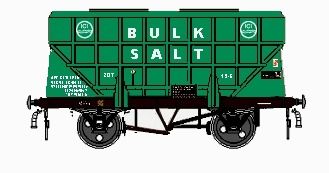
I was not
sure about the accuracy of this livery (which appeared on the early Hornby
presflo) so I asked on the uk.rec.models.rail newsgroup and David Belcher was
able to advise:
The ICI livery is totally genuine (though the Tri-ang TT version lacked ICI branding); the real things worked between Stoke Prior (near Droitwich Spa) and Winsford, probably in block trains. There were minor detail differences compared to powder-carrying Presflos; I seem to recall seeing an article in a very old issue of RM regarding modifications to the Airfix model to produce an ICI salt wagon.
I think they appeared in the mid-to-late '50s at around the same time as the standard Presflo, and were possibly built at the Butterly Company's works in Derbyshire. They couldn't have lasted long working the traffic they were intended for, though, as salt production at ICI Stoke Prior stopped in 1964, the site being completely re-developed not long after for polymer manufacture. Presumably they ended up on shorter runs in the Cheshire salt field before withdrawal.
David E. Belcher
Subsequently Paul Bartlett posted some pictures of the slate variant on his website (see App 7 - Useful Websites).
The later 'presstwin' twin silo cement hoppers also appeared in PO liveries, the short version was seen in Fisons Fertilisers livery, some of the longer type ran in Blue Circle livery (as was available in the Lima N Gauge range - shown below)
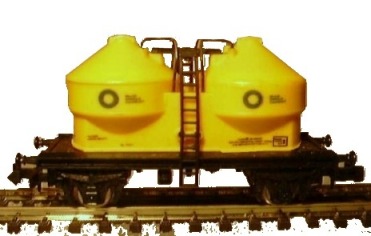
In 1968 a fleet of
bogie curtain sided vans were built for fertiliser traffic, operated by BRT
they were leased to Shellstar for fertiliser traffic. The curtain sides proved
unsatisfactory as if the load moved they bulged outward making the vehicle out
of gauge so in (I think) the mid 1970's they had new sides fitted with pairs of
double doors. The curtain sides made adding markings difficult and the vans
were fitted with a rectangular plate on the left hand end (bolted to the
triangular end support) to carry the TOPS markings. Under TOPS they were coded
PWA (later I believe this became JWA). Inside there were partitions between
each pair of doors so the van could move part-loaded without the pallets of
bagged fertiliser sliding about. I am not sure who Shellstar were but by the
1980's the vans wore UKF livery as shown below. The sketch is based on an
example seen at the Rocket 150 exhibition in Manchester in (I think) 1982 but
these vans actually carried a number of liveries over the years. Paul
Bartlett's web site (see App 7 Useful Links) has a selection of photographs
showing those from the later 1970's to the 90's. UKF were taken over by Kemira
(a Finnish chemical and fertiliser company) in 1988, the trading name changing
to Kemira Ince Ltd., and the vans were repainted in that companies blue livery
with white lettering. Kemira had been operating a fertiliser plant in the UK
trading as Kemira Ltd since 1982 but I have not traced any information on
railway rolling stock associated with this operation. The traffic was lost to
road in 1993 and the vans themselves were scrapped in 1994.
John Grey
offers an etched brass kit of this van in N and Lima used to have one in their
OO range but the slab-sided design is not too difficult to scratch-build. I
have conflicting information on the length of this vehicle but I believe it
should be about 97 mm over headstocks for British N with doors 15 mm high and
the diagonals at the ends should be about 5mm wide at the base.
Fig
___ UKF bogie van

Kemira Ince Ltd (formerly UKF) also had a fleet of
four wheeled tank wagons which ran in UKF livery carrying liquid anhydrous
ammonia (NH3), used in the production of fertiliser. Kemira Ince Ltd switched
to road transport in the early 1990's but the last I heard was that the sidings
are still in place and there has been talk of a return to rail.
By the mid 1970's British Rail had seen the advantages of private owner stock in reducing its own capital investment and was actively encouraging their use. Some firms with substantial contracts resisted, English China Clays had a fleet of hoppers (based on the standard HAA MGR coal hopper) built by British Rail to replace the fleet of old wooden bodied, vacuum braked, 'clay hoods'. These wagons travel as far as northern Scotland to paper works at Port Elphinstone near Inverurie.
British Steel built a fleet of 102 GLW (tons Gross
Loaded Weight) bogie tipplers for use feeding their works with imported ore
(which contains more iron than the domestic product). They ran to Llanwern in
South Wales from Port Talbot, to Scunthorpe from Immingham and to Ravenscraig
near Glasgow from the Clyde. Some also supplied the BSC works at Tees Side and
when this plant closed (in the late 1970's I believe) some of these wagons were
sold to Procor (a wagon building and leasing firm) who reconditioned them and
leased them to Foster Yeoman for stone traffic in 1981. Taylor Plastic Models
have now released a kit of the type. These wagons were augmented in the later
1970's by longer lower wagons of a broadly similar design. In N the Lima
'London Brick' tippler wagon can be repainted to represent these later wagons.
Fig___ BSC tippler wagon 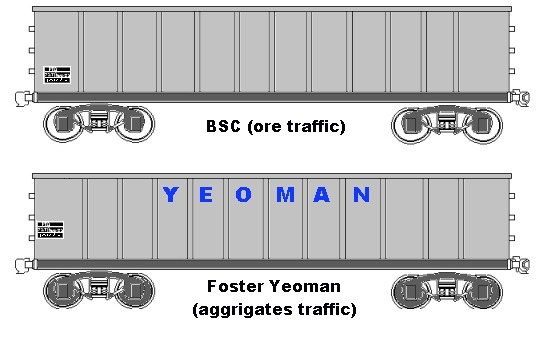
British Steel
painted the wagons light grey with black chassis, I believe the Yeoman wagons
were painted light grey with Yeoman in blue as shown and a black chassis.
Steel scrap, iron ore and large billets of steel are all regular
cargoes for which the private sector has catered. British Rail had some
re-bodied former 21 ton mineral wagons which they used for scrap traffic, these
were essentially similar to the 21 tonner but had only a single door on each
side.
BR built two prototypes of high bodied scrap carrying wagons,
diverting two chassis from the HBA building program, fitting a high steel body
and coding them MFA. These wagons were amongst the first to feature a heavily
ribbed 'tippler' type body with five heavy posts on each side. These two wagons
were intended to show the industry the sort of vehicle BR thought would serve
well for the work, they resembled a re-bodied mineral wagon in having a single
side door but the body itself was nearly eight feet high (about seven feet
eight inches I believe) so an access ladder was added at one end. Railease, the
leasing subsidiary of Standard Railway Wagon Co. marketed a prototype air
braked POA four wheeler scrap vehicle in 1978, very similar to the BR built
wagons, but little interest was shown at first. The final development of this
vehicle, coded PNA under TOPS appeared in 1983, based on the HAA merry go round
hopper wagon chassis. By this time the leasing arm of the company had changed
its name from Railease to Standard Railfreight. A kit of the PNA is available
from Taylor Plastic Models. The design proved a success and British Rail
rebodied some redundant chassis with essentially similar bodies, coding these
SSA under TOPS. The POAs were progressively re-bodied from about 1987 with a
modified body design as the older vehicles started to suffer from rust and
loading/unloading damage in use. See also Freight Operations - Steel for
further information and a drawing.
All the POA/PNA wagons were sold to
BR in 1990 who recoded them SSA and ran them with their own SSA wagons. They
then passed to EWS, who repainted them in their house colours of maroon and
yellow.
Sheerness Steel in Kent commissioned some 102 ton GLW bogie
wagons from Procor (a wagon building and leasing company) to carry both scrap
metal and finished steel to and from their works, again making use of Speedlink
services. (I believe the Sheerness works closed in 2002, part of the collapse of Allied Steel and Wire)
See also Freight Operations - Steel for further information
on scrap wagons
Fig
___ Scrap steel air braked wagons
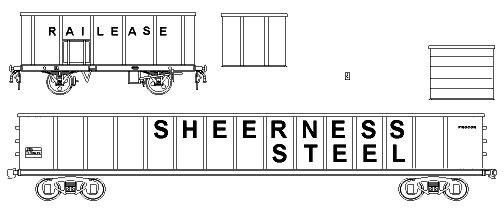
Up to the early 1990's Redland Tile was the largest rail
connected concrete products firm. They opened for business in 1919 as the
Redhill Tile Company, producing concrete roofing tiles at Reigate in Surrey. By
1939 the concrete roof tile was well established with a 22 percent market share
and Redhill had additional works in Yorkshire and Leicestershire. After the
Second World War Redhill began a programme of acquiring smaller firms and by
1948 the name had changed to Redland. In 1955 the firm acquired the Bursledon
Brick Company and a concrete pipe manufacturing firm (subsequently sold off in
1981). In 1981 Redland merged with Cawoods aggregate business and the two firms
were consolidated under the Redland banner. In 1995 Redland moved into the
general aggregates (broken stone) business, buying a major stake in Ennemix, in
the same year it sold its china clay operation in Cornwall to ECC. In 1996
Redland sold their brick making business to Ibstock for £160m, giving
Ibstock a 35% of the British market. Also in 1996 Redland sold its European
tile making business to its German subsidiary (Braas) but continued to trade
under the Redland name in the UK. In 1998, Redland Roofing Systems became a
member of Lafarge Roofing, the world's largest dedicated roofing products
manufacturer.
Throughout the 1980's Redland was a regular user of rail
transport, employing five types of wagon. Three of these were open designs some
of which were painted in company livery; twelve Procor PNA bogie drop-side,
sixteen Procor PFA standard wagons and fifteen British Railways OAA wagons.
Some of the OAA wagons had clip-on raised ends fitted to increase their height
and allow a second layer of pallets to be carried. Redland open wagons
operating in the North East were reported in two-tone green in 1985 but when I
enquired in 1988 the firm advised me that the official body colour was a light
grey. The company livery consisted of the name Redland (only the R is
capitalised) to the upper left on the 4 wheel stock and in both the upper right
and left corners of the bogie stock, the lettering being about 16 inches high.
Other markings such as the word FRAGILE (5 inches high) and NOT TO BE LOOSE OR
HUMP SHUNTED (3 inches high) are in black on a yellow rectangle, the TOPS
markings are in white on a black ground. Brake wheels are white and the roller
bearing axle boxes are painted yellow.
The majority of the product
(roofing tiles) was strap banded and carried in open wagons. The cargo was
packed in with old motor car tyres which often show above the load.
In
the 1980's they also shipped pallets in a fleet of covered stock comprising
eight IPB large bogie vans leased from VTG and fourteen British Rail VDA vans,
as far as I am aware these remained in their owners colours. All six Redland
depots (Acton NW London, Gateshead near Newcastle, Cardiff, Southampton,
Dewsbury and Hull) were rail connected. Raw materials were supplied (some by
rail) from works at Leighton Buzzard, Lutterworth, Tiverton, Stirling, Swaffham
and Stanton.
A company called Plasmor use power station ash to mixed
with concrete to lightweight blocks which are used for building construction.
In 1987 Plasmor began using rail to move their product and the savings in
transportation costs allowed them to break into the lucrative London building
market. The blocks are light grey in colour, about a foot wide, eighteen inches
long and six inches thick (30cm x 45cm x 15cm), they are banded together to
form oblongs about four foot high, four foot long and two foot six wide (120cm
x 120cm x 75cm). They were shipped from the Plasmor depot near Doncaster on OBA
wagons which were fitted with raised end extensions to allow double stacking.
Railfreight Construction sector was responsible for the delivery of empty
wagons to the depot and the collection of loaded wagons which were hauled
(usually by a Class 31) to the Speedlink yard at Doncaster. Here the wagons
were sorted into their respective Speedlink trains for delivery.
Fig
___ British Rail wagons in Redland & Plasmoor liveries
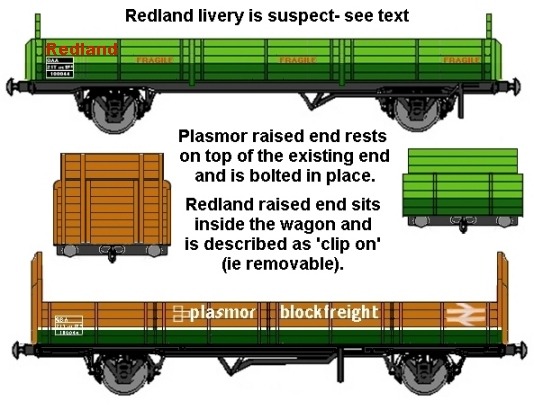
Following the merger with Redland in 1981 Cawoods retained the fuel
distribution side under their own banner and, at least up to 2001 they were
major operators of coal container services. Cawoods use yellow containers with
the firms name in black either vertically on the left hand end or in large
letters centrally on the sides. These coal container services are fully
discussed in the section on Freight Operations - Coal.
One of the first companies to make
regular use of the all air braked Speedlink services was Campbell's Soups. BRT
the wagon leasing company converted some redundant VDA vans in the early
1970's, fitting them with sides made up of four quarter length sliding doors
(the central pair being set out to clear the end pair). These vans were painted
plain blue (there is a photograph on Paul Bartlett's website showing one of
these early vans, see App 7 Useful Websites). Some of these were re-converted
in 1981 by fitting them with curtain sides bearing their logo. These distinctive curtain sided vans are available in N as an etched
brass kit from John Grey (see Available Models section for details). I believe
Pedigree foods had a similar rake of curtain sided vans which ran as a block
train but I was not able to find the only illustration I have so I was not able
to attempt a sketch.
I believe Pedigree Foods had at least one similar
curtain sided van bearing their logo in the later 1970's, in the mid 1980's
they used a fleet of bogie container flat wagons (built by Charter Rail) to
carry thirty foot long 'swap bodies' but I am told these were 'plain bauxite'
and did not carry the logo (I am still chasing information on the Pedigree
foods stock). See Freight Operations - PO Wagons for more information on these
traffics.
Fig___ Campbell's soup van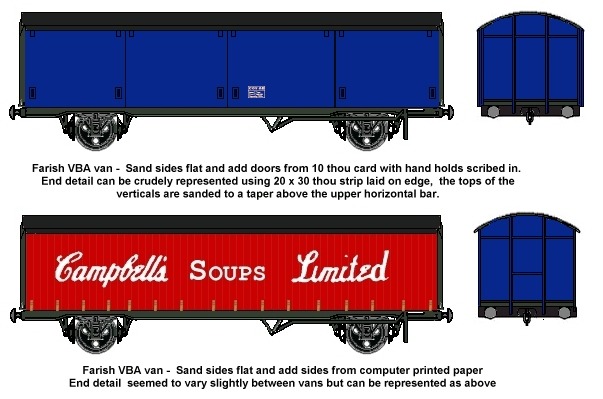
The introduction of TOPS in the mid 1970's meant that all private owner wagons, tanks and vans had to have their TOPS data panel added, this is always toward the lower left of the body. Some vehicles did not carry the TOPS plate but instead had an oval yellow plate bolted to the left hand end of the solebar. The actual owner had to be identified (rather than just the firm using the vehicle) so the yellow plate was marked with the owning company and the individual wagon number in black. These plates were all in place by 1970 but the older wagon numbers often remained painted on the sides. From the mid 1970's the 'hazchem' symbol was required on all vehicles carrying dangerous cargo. The Hazchem markings are discussed in detail under Livery - Tank Wagons.
The aggregates boom of the 1970's saw large numbers of PGA fifty ton hopper wagons appear on the system and redundant British Steel 100 ton tipplers were overhauled and offered for service in the 1980's and continues in service into the early 1990s (possilby later)(see Fig ___).
British Leyland motor cars used rail to transport a wide range of car parts between their various factories. To cater for British Leyland traffic, specifically engines, BR
modified some of its very large four wheeled ferry vans in the late 1960's or
early 1970s (British Leyland was only formed in 1968). These were coded VQX I
believe. The sides were removed and replaced with dark blue curtain sides
(Humbrol Oxford Blue is a fair match I believe), the curtain sides had the logo
and company name on them in white. The ends and roof were all painted in a very
slightly lighter blue than the curtains. These vehicles retained the RIV
international ferry markings and fittings (the markings were moved to the ends
as shown below) and the securing lugs remained in place but I do not know if
they were used for export traffic or if they operated between BL factories in
the UK. By the early 1980's they were stored out of use.
Fig___
British Leyland (ex BR Ferry) Van
The advantage here
is that the curtain side is much easier to model than the sides and
drop-flap ventilators on the sides of the original ferry vans. A model, in N,
should be 86.5mm over headstocks with a wheelbase of 54mm. The curtain sides
should be 14mm high and wrap over the ends by about 0.5mm. The two rows of
small white rings on the drawing are the lacing rings for the sides, the upper
row were along the bottom edge of a separate short curtain near the top of the
sides. As noted by Bernard Taylor in his article of BR Ferry Wagons in
Practical Model Railways magazine (see bibliography) the long wheelbase of this
vehicle makes for problems on the tight curves of a model railway. He built his
model of the ferry van on a continental steel wagon chassis which had pivoted
axles for this very reason.
In the later 1970's Ford required a replacement for the elderly palvans built by British Rail for their inter-factory parts traffic. A design was drawn up in consultation with British Rail and a fleet of sliding wall vans was ordered from Cargowaggon, a German rolling stock manufacturer. The Ford vans had a simple livery of light grey body and roof, black chassis and Ford's logo on one door in dark blue and white.
Fig ___ Ford Vans.

The Ford vans proved a great success and the design formed the basis for the British Rail feet of VGA wagons.
In the early 1980's Ford motor car company replaced
their older sliding side vans (as offered by Peco) with a new set of air braked
four wheeled vans built by Cargowaggon for Ford's own traffic in parts. These
new vans are about forty seven foot long and use a similar sliding side design
to the VGA vans.
Fig ___ Cargowaggon Ford van and general
service variant
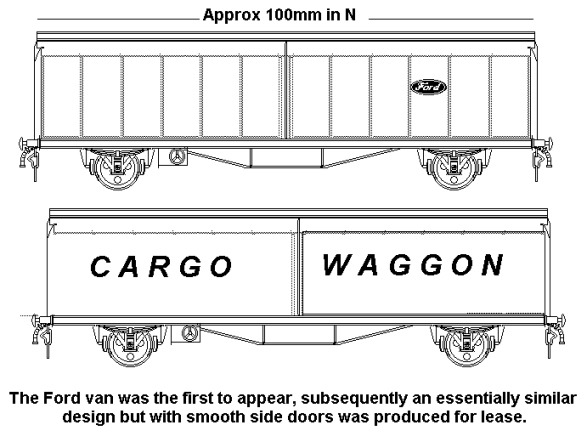
North Sea ferry traffic into the UK has brought a number of leased
continental wagons onto British lines. The distinctive VTG telescopic roof van
has proved a great success and has been used for a number of jobs including
steel coil. Another popular German vehicle is the large bogie sliding wall
ferry van, also operated by VTG and available from Roco (part number 2367A).
Fig ___ VTG bogie ferry van

The French Debauch Vite bogie ferry wagon has found favour with a number of operators and many variants of this vehicle have been built, including some by British Rail for carrying steel. The basic wagon design consists of a lengthy bogie flat wagon with raised 'van' type ends and a series of metal hoops supporting a tarpaulin cover. The hoops can be moved along the wagon, drawing back the tarpaulin to reveal the load and offering access for an overhead crane if required. The original Transfesa wagons were in Transferry livery, later examples were in Transfesa livery. Both of these had dark blue tarpaulins with white lettering. Tiphook have a number of similar wagons, their livery uses various colours depending on the wagon in question but features a large 'R' made up of horizontal lines. Similar wagons have been used for fertiliser traffic from the Norsk Hydro (Fissons until 1982) plant in Middlesborough and the livery of plain black with white markings makes this an attractive option as a photocopier can be used to produce the 'canvass hood' of the vehicle. The alternative livery for Norsk Hydro is blue with yellow lettering, but the layout is the same as shown.
Fig ___ Liveries on debauche vite wagons
